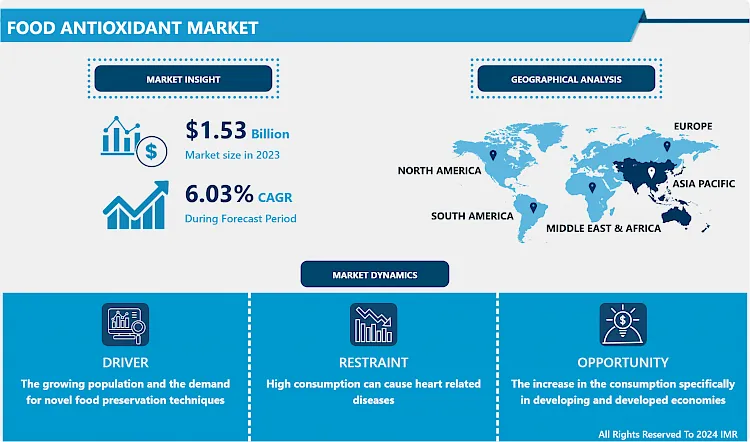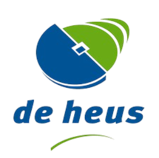Food Antioxidant Market Overview
The Global Food Antioxidants market was estimated at USD 1.53 billion in 2023, and is anticipated to reach USD 2.59 billion by 2032, growing at a CAGR of 6.03% over the analysis period 2024-2032.
- Antioxidants are natural compounds that minimize damage caused owing to oxygen. It is often referred to as a substance that obstructs oxidation it prevents chemical reaction obtained by free radicals that leads to chain reaction thereby damaging the cells of organisms. It aids to neutralize free radicals in our body. The popular antioxidants are vitamin C, vitamin E, and beta carotene which can prevent the damaging effects of oxidation. Owing to their high stability and low volatility, the antioxidants support to maintain the level of nutrients, the color, functionality, taste, freshness, aroma, texture, and appeal to consumers such as the older person, ceteris paribus. Furthermore, antioxidants are not only in food additives but are also to begin in food supplements and levels should be measured, as such, in body tissues and fluids. In addition, lesser-known sources of antioxidants to that cited in reference abound, for instance, black chokeberry (Aronia melanocarpa) found in jams, juices, purees, and along with, containing high levels of polyphenols and flavonoids, has the ability to interventive value for a range of chronic diseases such as diabetes and cardiovascular diseases which leads to the growth of the market over the forecast period. Fermented grain food supplements also hold antioxidants, e.g., Antioxidant Biofactor, lowering lipid oxidation by searching upon the peroxyl radical.

Market Dynamics and Factors for the Food Antioxidant Market:
Drivers:
- The world economic decline had a low effect on the global antioxidants market and the market for antioxidants is anticipated to continue to witness growth over the forecast period. However, shifting eating patterns are influencing the market growth regionally, owing to switching diet patterns, urbanization and population, and economic growth.
- Owing to rising life expectancy and strong growth of the agriculture sector, the demand for feed antioxidants in the global meat industry is anticipated to grow over the forecast period. India and Brazil are amongst the global rapidly emerging economies and are witnessing continuous growth in their per capita income. This may cause a standard shift in dietary preferences in these economies.
- Antioxidants are applied to food products to preserve their nutrients, flavor, and freshness, thereby intercepting food wastage and extending their overall shelf life. In many situations, two or more antioxidants are used in a food product to boost their food quality protection standards. Preservatives are also used in commercial products to maintain their freshness for a longer time and protect them from bacteria. Antioxidant support prevents oxidation of food containing fat or oil and thereby, prevents it from going foul-smelling.
- Apart from that, they prevent the browning of vegetables, cut fruit and fruit juices, and improve their shelf life. For instance, vitamin C, which is also called ascorbic acid, helps recycle vitamin E. Ascorbates, such as vitamin C, help to detach oxygen through the self-oxidation process. For instance, monosodium glutamate is used in processed foods, such as soups, sausages, and sauces. Due to these applications, the demand for antioxidants is anticipated to observe a surge globally, mainly from the packaged food industry.
Restraints:
- Some antioxidants are somehow can be high in different food products. Consuming large amounts of antioxidants continuously can grow triglyceride levels, a type of fat in the bloodstream. It raises the risk of heart disease and it can also poorly affect dental health. These are some of the factors that are hampering the growth of the market.
Opportunity:
- Rising demand in developing economies for food antioxidants. Though awareness regarding food antioxidants is low, developing economies such as China and India are facing high industrialization. As these developing economies grow and gain high disposable income, their demand for food antioxidants is also growing. The APAC region is displaying increased demand for prepared and functional foods & beverages, and thus, the region's food antioxidants market is anticipated to grow. The demand for food antioxidants is anticipated to grow at a quiet pace in early acquiring countries such as Japan, Germany, and a fractional rate in new & developing markets such as Thailand, Malaysia, and other Asian economies.
- Furthermore, the rising world population is putting more pressure on manufacturers for the preparation, extraction, and maintenance of scarce resources. Growing energy prices and increasing raw material costs are affecting food prices, thus impacting low-income consumers. Pressure on food supplies is being compounded by water shortages, particularly over Africa and Northern Asia. Advances in science and technology are helping in improving the shelf life of foods to a greater extent. The requirement for marketing food preservatives to the smallest of food & beverage manufacturers will expand the market size.
Market Segmentation
- Based on Type, the synthetic segment accounted for the maximum share in the food antioxidant market. Synthetic food antioxidants are manufactured from petroleum-based products. They are utilized primarily in the food industry to delay lipid oxidation for stabilizing and preserving refined fats & oils within a food system/product. The maximum acceptable limit for synthetic antioxidants varies greatly over countries and is dependent on the food it is being used in. Four types of synthetic antioxidants are mostly used in foods such as BHA, BHT, PG, and TBHQ.
- Based on Application, the prepared meat & poultry segment accounted for the maximum market share as well as the highest growth rate in the food antioxidants market. The usage of antioxidants can improve the shelf life of meat & poultry products. Prepared meat & poultry products comprising of fat along with unsaturated fatty acids undergo oxidative degradation during storage. Antioxidants hinder lipid oxidation and minimize rancidity without any unacceptable impact on the nutritional or sensory properties, resulting in quality preservation and boost the shelf life of meat & poultry products.
- Based on Form, the dry segment dominates the food antioxidant market over the forecast period. Numerous synthetic food antioxidants are in the dry form, which incorporates fine granular, fine powder, flakes, and tablets. The dry segment recorded a market share in the year 2018. It observes higher demand among food producers, as they are easy to mix with various food products such as prepared meat & poultry products, bakery & confectionery, prepared snacks, and are easy to store and handle. The producers process them to convert them into a form highly suitable for stakeholders.
- Based on Source, the market is categorized into fruits and vegetables, oils, spices & herbs, botanical extracts, gallic acids, nuts & seeds, and petroleum. There are various natural sources from where antioxidants are obtained. Depending on the further application, the source is decided. Fruits and vegetables and nuts and seeds are utilized as they are. Oils are usually added to prepared foods to enhance their shelf life and inhibit oxidation.
Players Covered in Food Antioxidant market are :
- VDH Chem Tech Pvt Ltd (India)
- Yasho Industries (India)
- Nagase Group (Japan)
- Fooodchem International Corporation (US)
- Guangzhou ZIO Chemicals Co. Ltd (China)
- Koninklijke DSM N.V. (Netherlands)
- Kemin Industries Inc. (the US)
- DuPont (US)
- Eastman Chemical Company (US)
- Barentz Group (Netherlands)
- Camlin Fine Sciences (India)
- Kalsec Inc. (US)
- Frutarom Ltd (Israel)
- BTSA (Spain)
- Archer-Daniels-Midland Company (US)
- Vitablend Nederland BV (Netherlands)
- Sasol Limited (South Africa)
- Advanced Organic Materials (Germany)
- Crystal Quinone Pvt Ltd. (India)
- Oxiris Chemicals S.A (Spain)
- Pharmorgana GmBH (Germany)
- Naturex (France)
- BASF SE (Germany)
- 3A Antioxidants (US) and Other major players.
Regional Analysis for Food Antioxidant Market:
- In the Asia Pacific region, the food & beverages sector is greatly impacted by the consumer preference for healthy consumption, the trend towards natural and organic foods, and the rising need for convenience food products. With developing countries, increasing industrialization, rising urge for processed foods, and consumer preference for quality products, ingredient suppliers are becoming growingly optimistic about the growth of the food & beverage industry. These trends and preferences have generated a need for new additives in foods, despite the growing consciousness regarding the health hazards related to synthetic food additives.
- The European region is propelled by UK, France, and German food antioxidants market and is expected to gain maximum market share during the forecast period. The product helps to improve the shelf life of bakery products. Growing demand for bakery products due to their appealing taste and easy-to-digest nature is probably to turn regional market growth.
- In Latin America, Brazil's food antioxidants market size may witness remarkable gains in the projected period owing to growing meat and meat product demand. The product is used by meat suppliers to enhance the shelf life of meat products. Rising consciousness regarding nutritious diet and the need to impart genetic taste will act as a crucial role in accelerating the industry size.
Key Industry Developments of the Food Antioxidant Market:
- In July 2024, DuPont Nutrition & Health highlighted groundbreaking solutions for the food and beverage industry at the IFT18 Food Expo, Booth S1062. The company introduced new innovations, including POWERBake 6000 enzymes, CHOOZIT SWIFT 600 cultures, and GUARDIAN TOCO 30P antioxidants. DuPont’s protein experts participated in three educational sessions on plant-based protein, discussing the latest trends in meat alternatives and food applications.
- In September 2023, INEOS Group announced the acquisition of the Eastman Texas City site, including a 600kt Acetic Acid plant and associated third-party activities, for approximately $500 million. The deal, which also includes a Memorandum of Understanding for a long-term vinyl acetate monomer supply agreement, is set to close by the end of 2023, pending regulatory approval. INEOS plans to invest in and expand the site, with all employees transferring to INEOS post-transaction.
|
Food Antioxidant Market |
|||
|
Base Year: |
2023 |
Forecast Period: |
2024-2032 |
|
Historical Data: |
2017 to 2023 |
Market Size in 2023: |
USD 1.53 billion |
|
Forecast Period 2024-32 CAGR: |
6.03 % |
Market Size in 2032: |
USD 2.59 billion |
|
Segments Covered: |
By Type |
|
|
|
By Application |
|
||
|
By Source |
|
||
|
By Form |
|
||
|
By Region |
|
||
|
Key Market Drivers: |
|
||
|
Key Market Restraints: |
|
||
|
Key Opportunities: |
|
||
|
Companies Covered in the report: |
|
||
Chapter 1: Introduction
1.1 Research Objectives
1.2 Research Methodology
1.3 Research Process
1.4 Scope and Coverage
1.4.1 Market Definition
1.4.2 Key Questions Answered
1.5 Market Segmentation
Chapter 2:Executive Summary
Chapter 3:Growth Opportunities By Segment
3.1 By Type
3.2 By Application
3.3 By Source
3.4 By Form
Chapter 4: Market Landscape
4.1 Porter's Five Forces Analysis
4.1.1 Bargaining Power of Supplier
4.1.2 Threat of New Entrants
4.1.3 Threat of Substitutes
4.1.4 Competitive Rivalry
4.1.5 Bargaining Power Among Buyers
4.2 Industry Value Chain Analysis
4.3 Market Dynamics
3.5.1 Drivers
3.5.2 Restraints
3.5.3 Opportunities
3.5.4 Challenges
4.4 Pestle Analysis
4.5 Technological Roadmap
4.6 Regulatory Landscape
4.7 SWOT Analysis
4.8 Price Trend Analysis
4.9 Patent Analysis
4.10 Analysis of the Impact of Covid-19
4.10.1 Impact on the Overall Market
4.10.2 Impact on the Supply Chain
4.10.3 Impact on the Key Manufacturers
4.10.4 Impact on the Pricing
Chapter 4: Food Antioxidant Market by Type
4.1 Food Antioxidant Market Overview Snapshot and Growth Engine
4.2 Food Antioxidant Market Overview
4.3 Natural
4.3.1 Introduction and Market Overview
4.3.2 Historic and Forecasted Market Size (2017-2032F)
4.3.3 Key Market Trends, Growth Factors and Opportunities
4.3.4 Natural: Grographic Segmentation
4.4 Synthetic
4.4.1 Introduction and Market Overview
4.4.2 Historic and Forecasted Market Size (2017-2032F)
4.4.3 Key Market Trends, Growth Factors and Opportunities
4.4.4 Synthetic: Grographic Segmentation
Chapter 5: Food Antioxidant Market by Application
5.1 Food Antioxidant Market Overview Snapshot and Growth Engine
5.2 Food Antioxidant Market Overview
5.3 Prepared Foods
5.3.1 Introduction and Market Overview
5.3.2 Historic and Forecasted Market Size (2017-2032F)
5.3.3 Key Market Trends, Growth Factors and Opportunities
5.3.4 Prepared Foods: Grographic Segmentation
5.4 Prepared Meat & Poultry
5.4.1 Introduction and Market Overview
5.4.2 Historic and Forecasted Market Size (2017-2032F)
5.4.3 Key Market Trends, Growth Factors and Opportunities
5.4.4 Prepared Meat & Poultry: Grographic Segmentation
5.5 Fats & Oils
5.5.1 Introduction and Market Overview
5.5.2 Historic and Forecasted Market Size (2017-2032F)
5.5.3 Key Market Trends, Growth Factors and Opportunities
5.5.4 Fats & Oils: Grographic Segmentation
5.6 Beverages
5.6.1 Introduction and Market Overview
5.6.2 Historic and Forecasted Market Size (2017-2032F)
5.6.3 Key Market Trends, Growth Factors and Opportunities
5.6.4 Beverages: Grographic Segmentation
5.7 Bakery 7 Confectionery
5.7.1 Introduction and Market Overview
5.7.2 Historic and Forecasted Market Size (2017-2032F)
5.7.3 Key Market Trends, Growth Factors and Opportunities
5.7.4 Bakery 7 Confectionery: Grographic Segmentation
5.8 Seafood And
5.8.1 Introduction and Market Overview
5.8.2 Historic and Forecasted Market Size (2017-2032F)
5.8.3 Key Market Trends, Growth Factors and Opportunities
5.8.4 Seafood And: Grographic Segmentation
5.9 Others
5.9.1 Introduction and Market Overview
5.9.2 Historic and Forecasted Market Size (2017-2032F)
5.9.3 Key Market Trends, Growth Factors and Opportunities
5.9.4 Others: Grographic Segmentation
Chapter 6: Food Antioxidant Market by Source
6.1 Food Antioxidant Market Overview Snapshot and Growth Engine
6.2 Food Antioxidant Market Overview
6.3 Fruits And Vegetables
6.3.1 Introduction and Market Overview
6.3.2 Historic and Forecasted Market Size (2017-2032F)
6.3.3 Key Market Trends, Growth Factors and Opportunities
6.3.4 Fruits And Vegetables: Grographic Segmentation
6.4 Oils
6.4.1 Introduction and Market Overview
6.4.2 Historic and Forecasted Market Size (2017-2032F)
6.4.3 Key Market Trends, Growth Factors and Opportunities
6.4.4 Oils: Grographic Segmentation
6.5 Spices & Herbs
6.5.1 Introduction and Market Overview
6.5.2 Historic and Forecasted Market Size (2017-2032F)
6.5.3 Key Market Trends, Growth Factors and Opportunities
6.5.4 Spices & Herbs: Grographic Segmentation
6.6 Botanical Extracts
6.6.1 Introduction and Market Overview
6.6.2 Historic and Forecasted Market Size (2017-2032F)
6.6.3 Key Market Trends, Growth Factors and Opportunities
6.6.4 Botanical Extracts: Grographic Segmentation
6.7 Gallic Acids
6.7.1 Introduction and Market Overview
6.7.2 Historic and Forecasted Market Size (2017-2032F)
6.7.3 Key Market Trends, Growth Factors and Opportunities
6.7.4 Gallic Acids: Grographic Segmentation
6.8 Nuts & Seeds
6.8.1 Introduction and Market Overview
6.8.2 Historic and Forecasted Market Size (2017-2032F)
6.8.3 Key Market Trends, Growth Factors and Opportunities
6.8.4 Nuts & Seeds: Grographic Segmentation
6.9 Petroleum
6.9.1 Introduction and Market Overview
6.9.2 Historic and Forecasted Market Size (2017-2032F)
6.9.3 Key Market Trends, Growth Factors and Opportunities
6.9.4 Petroleum: Grographic Segmentation
Chapter 7: Food Antioxidant Market by Form
7.1 Food Antioxidant Market Overview Snapshot and Growth Engine
7.2 Food Antioxidant Market Overview
7.3 Dry
7.3.1 Introduction and Market Overview
7.3.2 Historic and Forecasted Market Size (2017-2032F)
7.3.3 Key Market Trends, Growth Factors and Opportunities
7.3.4 Dry: Grographic Segmentation
7.4 Liquid
7.4.1 Introduction and Market Overview
7.4.2 Historic and Forecasted Market Size (2017-2032F)
7.4.3 Key Market Trends, Growth Factors and Opportunities
7.4.4 Liquid: Grographic Segmentation
Chapter 8: Company Profiles and Competitive Analysis
8.1 Competitive Landscape
8.1.1 Competitive Positioning
8.1.2 Food Antioxidant Sales and Market Share By Players
8.1.3 Industry BCG Matrix
8.1.4 Ansoff Matrix
8.1.5 Food Antioxidant Industry Concentration Ratio (CR5 and HHI)
8.1.6 Top 5 Food Antioxidant Players Market Share
8.1.7 Mergers and Acquisitions
8.1.8 Business Strategies By Top Players
8.2 VDH CHEM TECH PVT LTD (INDIA)
8.2.1 Company Overview
8.2.2 Key Executives
8.2.3 Company Snapshot
8.2.4 Operating Business Segments
8.2.5 Product Portfolio
8.2.6 Business Performance
8.2.7 Key Strategic Moves and Recent Developments
8.2.8 SWOT Analysis
8.3 YASHO INDUSTRIES (INDIA)
8.4 NAGASE GROUP (JAPAN)
8.5 FOOODCHEM INTERNATIONAL CORPORATION (US)
8.6 GUANGZHOU ZIO CHEMICALS CO. LTD (CHINA)
8.7 KONINKLIJKE DSM N.V. (NETHERLANDS)
8.8 KEMIN INDUSTRIES INC. (THE US)
8.9 DUPONT (US)
8.10 EASTMAN CHEMICAL COMPANY (US)
8.11 BARENTZ GROUP (NETHERLANDS)
8.12 CAMLIN FINE SCIENCES (INDIA)
8.13 KALSEC INC. (US)
8.14 FRUTAROM LTD (ISRAEL)
8.15 BTSA (SPAIN)
8.16 ARCHER-DANIELS-MIDLAND COMPANY (US)
8.17 VITABLEND NEDERLAND BV (NETHERLANDS)
8.18 SASOL LIMITED (SOUTH AFRICA)
8.19 ADVANCED ORGANIC MATERIALS (GERMANY)
8.20 CRYSTAL QUINONE PVT LTD. (INDIA)
8.21 OXIRIS CHEMICALS S.A (SPAIN)
8.22 PHARMORGANA GMBH (GERMANY)
8.23 NATUREX (FRANCE)
8.24 BASF SE (GERMANY)
8.25 3A ANTIOXIDANTS (US)
8.26 OTHERS
Chapter 9: Global Food Antioxidant Market Analysis, Insights and Forecast, 2017-2032
9.1 Market Overview
9.2 Historic and Forecasted Market Size By Type
9.2.1 Natural
9.2.2 Synthetic
9.3 Historic and Forecasted Market Size By Application
9.3.1 Prepared Foods
9.3.2 Prepared Meat & Poultry
9.3.3 Fats & Oils
9.3.4 Beverages
9.3.5 Bakery 7 Confectionery
9.3.6 Seafood And
9.3.7 Others
9.4 Historic and Forecasted Market Size By Source
9.4.1 Fruits And Vegetables
9.4.2 Oils
9.4.3 Spices & Herbs
9.4.4 Botanical Extracts
9.4.5 Gallic Acids
9.4.6 Nuts & Seeds
9.4.7 Petroleum
9.5 Historic and Forecasted Market Size By Form
9.5.1 Dry
9.5.2 Liquid
Chapter 10: North America Food Antioxidant Market Analysis, Insights and Forecast, 2017-2032
10.1 Key Market Trends, Growth Factors and Opportunities
10.2 Impact of Covid-19
10.3 Key Players
10.4 Key Market Trends, Growth Factors and Opportunities
10.4 Historic and Forecasted Market Size By Type
10.4.1 Natural
10.4.2 Synthetic
10.5 Historic and Forecasted Market Size By Application
10.5.1 Prepared Foods
10.5.2 Prepared Meat & Poultry
10.5.3 Fats & Oils
10.5.4 Beverages
10.5.5 Bakery 7 Confectionery
10.5.6 Seafood And
10.5.7 Others
10.6 Historic and Forecasted Market Size By Source
10.6.1 Fruits And Vegetables
10.6.2 Oils
10.6.3 Spices & Herbs
10.6.4 Botanical Extracts
10.6.5 Gallic Acids
10.6.6 Nuts & Seeds
10.6.7 Petroleum
10.7 Historic and Forecasted Market Size By Form
10.7.1 Dry
10.7.2 Liquid
10.8 Historic and Forecast Market Size by Country
10.8.1 U.S.
10.8.2 Canada
10.8.3 Mexico
Chapter 11: Europe Food Antioxidant Market Analysis, Insights and Forecast, 2017-2032
11.1 Key Market Trends, Growth Factors and Opportunities
11.2 Impact of Covid-19
11.3 Key Players
11.4 Key Market Trends, Growth Factors and Opportunities
11.4 Historic and Forecasted Market Size By Type
11.4.1 Natural
11.4.2 Synthetic
11.5 Historic and Forecasted Market Size By Application
11.5.1 Prepared Foods
11.5.2 Prepared Meat & Poultry
11.5.3 Fats & Oils
11.5.4 Beverages
11.5.5 Bakery 7 Confectionery
11.5.6 Seafood And
11.5.7 Others
11.6 Historic and Forecasted Market Size By Source
11.6.1 Fruits And Vegetables
11.6.2 Oils
11.6.3 Spices & Herbs
11.6.4 Botanical Extracts
11.6.5 Gallic Acids
11.6.6 Nuts & Seeds
11.6.7 Petroleum
11.7 Historic and Forecasted Market Size By Form
11.7.1 Dry
11.7.2 Liquid
11.8 Historic and Forecast Market Size by Country
11.8.1 Germany
11.8.2 U.K.
11.8.3 France
11.8.4 Italy
11.8.5 Russia
11.8.6 Spain
Chapter 12: Asia-Pacific Food Antioxidant Market Analysis, Insights and Forecast, 2017-2032
12.1 Key Market Trends, Growth Factors and Opportunities
12.2 Impact of Covid-19
12.3 Key Players
12.4 Key Market Trends, Growth Factors and Opportunities
12.4 Historic and Forecasted Market Size By Type
12.4.1 Natural
12.4.2 Synthetic
12.5 Historic and Forecasted Market Size By Application
12.5.1 Prepared Foods
12.5.2 Prepared Meat & Poultry
12.5.3 Fats & Oils
12.5.4 Beverages
12.5.5 Bakery 7 Confectionery
12.5.6 Seafood And
12.5.7 Others
12.6 Historic and Forecasted Market Size By Source
12.6.1 Fruits And Vegetables
12.6.2 Oils
12.6.3 Spices & Herbs
12.6.4 Botanical Extracts
12.6.5 Gallic Acids
12.6.6 Nuts & Seeds
12.6.7 Petroleum
12.7 Historic and Forecasted Market Size By Form
12.7.1 Dry
12.7.2 Liquid
12.8 Historic and Forecast Market Size by Country
12.8.1 China
12.8.2 India
12.8.3 Japan
12.8.4 Southeast Asia
Chapter 13: South America Food Antioxidant Market Analysis, Insights and Forecast, 2017-2032
13.1 Key Market Trends, Growth Factors and Opportunities
13.2 Impact of Covid-19
13.3 Key Players
13.4 Key Market Trends, Growth Factors and Opportunities
13.4 Historic and Forecasted Market Size By Type
13.4.1 Natural
13.4.2 Synthetic
13.5 Historic and Forecasted Market Size By Application
13.5.1 Prepared Foods
13.5.2 Prepared Meat & Poultry
13.5.3 Fats & Oils
13.5.4 Beverages
13.5.5 Bakery 7 Confectionery
13.5.6 Seafood And
13.5.7 Others
13.6 Historic and Forecasted Market Size By Source
13.6.1 Fruits And Vegetables
13.6.2 Oils
13.6.3 Spices & Herbs
13.6.4 Botanical Extracts
13.6.5 Gallic Acids
13.6.6 Nuts & Seeds
13.6.7 Petroleum
13.7 Historic and Forecasted Market Size By Form
13.7.1 Dry
13.7.2 Liquid
13.8 Historic and Forecast Market Size by Country
13.8.1 Brazil
13.8.2 Argentina
Chapter 14: Middle East & Africa Food Antioxidant Market Analysis, Insights and Forecast, 2017-2032
14.1 Key Market Trends, Growth Factors and Opportunities
14.2 Impact of Covid-19
14.3 Key Players
14.4 Key Market Trends, Growth Factors and Opportunities
14.4 Historic and Forecasted Market Size By Type
14.4.1 Natural
14.4.2 Synthetic
14.5 Historic and Forecasted Market Size By Application
14.5.1 Prepared Foods
14.5.2 Prepared Meat & Poultry
14.5.3 Fats & Oils
14.5.4 Beverages
14.5.5 Bakery 7 Confectionery
14.5.6 Seafood And
14.5.7 Others
14.6 Historic and Forecasted Market Size By Source
14.6.1 Fruits And Vegetables
14.6.2 Oils
14.6.3 Spices & Herbs
14.6.4 Botanical Extracts
14.6.5 Gallic Acids
14.6.6 Nuts & Seeds
14.6.7 Petroleum
14.7 Historic and Forecasted Market Size By Form
14.7.1 Dry
14.7.2 Liquid
14.8 Historic and Forecast Market Size by Country
14.8.1 Saudi Arabia
14.8.2 South Africa
Chapter 15 Investment Analysis
Chapter 16 Analyst Viewpoint and Conclusion
|
Food Antioxidant Market |
|||
|
Base Year: |
2023 |
Forecast Period: |
2024-2032 |
|
Historical Data: |
2017 to 2023 |
Market Size in 2023: |
USD 1.53 billion |
|
Forecast Period 2024-32 CAGR: |
6.03 % |
Market Size in 2032: |
USD 2.59 billion |
|
Segments Covered: |
By Type |
|
|
|
By Application |
|
||
|
By Source |
|
||
|
By Form |
|
||
|
By Region |
|
||
|
Key Market Drivers: |
|
||
|
Key Market Restraints: |
|
||
|
Key Opportunities: |
|
||
|
Companies Covered in the report: |
|
||
Frequently Asked Questions :
The forecast period in the Food Antioxidants Market research report is 2024-2032.
Nagase Group, Koninklijke DSM N.V., Barentz Group, Archer-Daniels-Midland Company, BASF SE, DuPont, Naturex, and Other Major Players.
The Food Antioxidants Market is segmented into Type, Application, Source, Form and Region. By Type, the market is categorized into Natural, and Synthetic. By Application, the market is categorized into Prepared Foods, Prepared Meat & Poultry, and Fats & Oils. By Source the market is categorized into Fruits & Vegetables, Oils, Spices & Herbs, Botanical Extracts, Gallic Acids, Nuts & Seeds, Petroleum. By Form, the market is categorized into Dry, and Liquid. By region, it is analyzed across North America (U.S.; Canada; Mexico), Europe (Germany; U.K.; France; Italy; Russia; Spain, etc.), Asia-Pacific (China; India; Japan; Southeast Asia, etc.), South America (Brazil; Argentina, etc.), Middle East & Africa (Saudi Arabia; South Africa, etc.).
Antioxidants are applied to food products to preserve their nutrients, flavor, and freshness, thereby intercepting food wastage and extending their overall shelf life. In many situations, two or more antioxidants are used in a food product to boost their food quality protection standards. Preservatives are also used in commercial products to maintain their freshness for a longer time and protect them from bacteria. Antioxidant support prevents oxidation of food containing fat or oil and thereby, prevents it from going foul-smelling.
The Global Food Antioxidants market was estimated at USD 1.53 billion in 2023, and is anticipated to reach USD 2.59 billion by 2032, growing at a CAGR of 6.03% over the analysis period 2024-2032.











